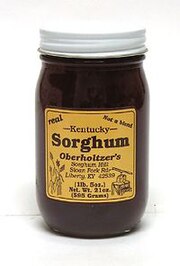Sweet sorghum: Difference between revisions
Mistral2099 (talk | contribs) mNo edit summary |
Indiamonsoon (talk | contribs) →Uses: added sentence on water efficiency |
||
| Line 20: | Line 20: | ||
Grain sorghum has also been utilized by the ethanol industry for quite some time because it yields approximately the same amount of ethanol per bushel as corn. As new generation ethanol processes are studied and improved, sorghum's role may continue to expand.<ref>{{cite web|url=https://rirdc.infoservices.com.au/items/13-087|title=Sweet sorghum – Opportunities for a new renewable fuel and food industry in Australia|publisher=RIRDC|accessdate=28 August 2013}}</ref> [[Texas A&M University]] is currently running trials to ascertain the best varieties for ethanol production from sorghum leaves and stalks in the USA.<ref>[http://agnewsarchive.tamu.edu/dailynews/stories/FUEL/Oct0107a.htm Ceres and Texas A&M to Develop and Market High-Biomass Sorghum for Biofuels<!-- Bot generated title -->] {{dead link|date=June 2012}}</ref> |
Grain sorghum has also been utilized by the ethanol industry for quite some time because it yields approximately the same amount of ethanol per bushel as corn. As new generation ethanol processes are studied and improved, sorghum's role may continue to expand.<ref>{{cite web|url=https://rirdc.infoservices.com.au/items/13-087|title=Sweet sorghum – Opportunities for a new renewable fuel and food industry in Australia|publisher=RIRDC|accessdate=28 August 2013}}</ref> [[Texas A&M University]] is currently running trials to ascertain the best varieties for ethanol production from sorghum leaves and stalks in the USA.<ref>[http://agnewsarchive.tamu.edu/dailynews/stories/FUEL/Oct0107a.htm Ceres and Texas A&M to Develop and Market High-Biomass Sorghum for Biofuels<!-- Bot generated title -->] {{dead link|date=June 2012}}</ref> |
||
In [[India]], and other places, sweet sorghum stalks are used for producing bio-fuel by squeezing the juice and then fermenting into [[ethanol]].<ref>{{cite web|url=http://www.agribusinessweek.com/sweet-sorghum-a-new-smart-biofuel-crop/|title=Sweet Sorghum : A New “Smart Biofuel Crop”|date=30 June 2008|publisher=Agriculture Business Week}}</ref> |
In [[India]], and other places, sweet sorghum stalks are used for producing bio-fuel by squeezing the juice and then fermenting into [[ethanol]].<ref>{{cite web|url=http://www.agribusinessweek.com/sweet-sorghum-a-new-smart-biofuel-crop/|title=Sweet Sorghum : A New “Smart Biofuel Crop”|date=30 June 2008|publisher=Agriculture Business Week}}</ref></ref>It is favoured as a biofuel crop in dryland conditions, as it only extracts one seventh of the water used by sugarcane.<ref> [http://resourcespace.icrisat.ac.in/filestore/8/4/0_6c06c9b61b19c20/840_be710da94740b90.pdf ''Sweet sorghum for food, feed and fuel''] New Agriculturalist, January 2008.</ref> |
||
== See also == |
== See also == |
||
Revision as of 12:44, 13 February 2014

Sweet sorghum is any of the many varieties of the sorghum plant which has a high sugar content. Sweet sorghum is a type of grass that thrives better under drier and warmer conditions than many other crops and is grown primarily for forage, silage, and syrup production.
Cultivation
Sweet sorghum has been widely cultivated in the U.S. since the 1850s for use in sweeteners, primarily in the form of sorghum syrup. By the early 1900s, the U.S. produced 20 million US gallons (76,000 m3) of sweet sorghum syrup annually. Making syrup from sorghum (as from sugar cane) is heavily labor intensive. Following World War II, with the declining availability of farm labor, sorghum syrup production fell drastically. Currently, less than 1 million US gallons (3,800 m3) are produced annually in the U.S.
Most sorghum grown for syrup production is grown in Alabama, Arkansas, Georgia, Iowa, Kentucky, Mississippi, North Carolina, and Tennessee.
Uses



Sorghum syrup and hot biscuits are a traditional breakfast in the Southern United States. Sorghum syrup is also used on pancakes, cornmeal mush, grits and other hot cereals. It can be used as a cooking ingredient with a similar sweetening effect as molasses, despite the fact that the nutritional content of blackstrap molasses still has a higher nutritional value than sorghum syrup in most regards. [1]
Sweet sorghum syrup is sometimes called "molasses" or "sorghum molasses" in some regions of the U.S., but the term molasses more properly refers to a different sweet syrup, made as a byproduct of sugarcane or sugar beet sugar extraction[citation needed].
In the U.S. since the 1950s, sorghum has been raised primarily for forage and silage, with sorghum cultivation for cattle feed concentrated in the Great Plains (Texas, Kansas, and Nebraska are the leading producers) where insufficient rainfall and high temperature make corn production unprofitable.
Grain sorghum has also been utilized by the ethanol industry for quite some time because it yields approximately the same amount of ethanol per bushel as corn. As new generation ethanol processes are studied and improved, sorghum's role may continue to expand.[2] Texas A&M University is currently running trials to ascertain the best varieties for ethanol production from sorghum leaves and stalks in the USA.[3]
In India, and other places, sweet sorghum stalks are used for producing bio-fuel by squeezing the juice and then fermenting into ethanol.[4]</ref>It is favoured as a biofuel crop in dryland conditions, as it only extracts one seventh of the water used by sugarcane.[5]
See also
- Camp Sorghum, historical use of sorghum molasses
References
- ^ "Sorghum Syrup". Spiritfoods. Retrieved 6 September 2012.
- ^ "Sweet sorghum – Opportunities for a new renewable fuel and food industry in Australia". RIRDC. Retrieved 28 August 2013.
- ^ Ceres and Texas A&M to Develop and Market High-Biomass Sorghum for Biofuels [dead link]
- ^ "Sweet Sorghum : A New "Smart Biofuel Crop"". Agriculture Business Week. 30 June 2008.
- ^ Sweet sorghum for food, feed and fuel New Agriculturalist, January 2008.
